25 Delicious Recipes That Start with S
Embark on a culinary journey as we explore 25 super delicious dishes from around the globe, all united by a common thread: they are items that start with S.
From savory diets to sweet delicacies, this collection showcases the incredible diversity and creativity found in the world’s cuisines.
Each dish tells a unique story of its place of origin, the people who have perfected it over generations, and the cultural influences that have shaped its flavors and preparation techniques.
As we journey through this alphabetical adventure, prepare to discover new taste sensations, learn about fascinating culinary traditions, and gain a deeper appreciation for the power of food to bring people together.
So, let’s dive in and explore these 25 mouthwatering items that start with S, and uncover the delicious wonders that await us.
Top Dishes that Start with the Letter ‘S’
1. Sushi (Japan)

Sushi is a renowned Japanese dish consisting of vinegared rice and various ingredients such as raw fish (sashimi), cooked seafood, vegetables, and sometimes tropical fruits. The rice is expertly seasoned with rice vinegar, sugar, and salt, creating a perfect balance of flavors. Sushi can be presented in various forms, including nigiri (raw fish atop pressed rice), maki (rice and fillings rolled in seaweed), and temaki (hand-rolled sushi cones).
- Region of Origin: Sushi originated in Southeast Asia to preserve fish by fermenting it in rice. It later spread to Japan, where it evolved into the dish we know today.
- Famous for: Sushi is celebrated for its delicate flavors, artistic presentation, and use of fresh, high-quality ingredients. The skilled preparation techniques and attention to detail make sushi a true culinary art form.
2. Spanakopita (Greece)

Description: Spanakopita is a beloved Greek pastry with a savory filling of spinach, feta cheese, onions, and herbs, all wrapped in layers of crispy, flaky phyllo dough. When baked, the filling is seasoned with salt, pepper, and sometimes nutmeg, creating a mouthwatering aroma. Spanakopita can be made as a large pie or individual triangular pastry, perfect for a snack or appetizer.
- Region of Origin: Spanakopita is believed to have originated in ancient Greece, with variations of the dish found throughout the country and its neighboring regions.
- Famous for: Spanakopita is renowned for its irresistible combination of crispy, golden-brown pastry and the creamy, tangy filling that bursts with flavor in every bite. It has become a staple in Greek cuisine and a favorite among food enthusiasts worldwide.
3. Samosas (India)

Samosas are a popular Indian snack that consists of a crispy, triangular pastry shell filled with a spiced mixture of potatoes, peas, onions, and sometimes meat. The filling is seasoned with an aromatic blend of cumin, coriander, ginger, and green chili, creating a flavorful and satisfying treat. Samosas are often served with chutney or yogurt dip and can be enjoyed as a snack or appetizer.
- Region of Origin: Samosas are believed to have originated in the Middle East and were introduced to the Indian subcontinent by Central Asian traders. They have since become an integral part of Indian cuisine, with regional variations throughout the country.
- Famous for: Samosas are celebrated for their bold spices, crispy exterior, and comforting, warm filling, which makes them a perfect snack for any occasion. They have gained global popularity and can be found in Indian restaurants and street food stalls worldwide.
4. Stroopwafel (Netherlands)

A stroopwafel is a delightful Dutch treat consisting of two thin, crispy waffles joined by a layer of gooey caramel syrup. The waffles are made from a batter of flour, butter, brown sugar, yeast, milk, and eggs, which is pressed in a hot waffle iron until golden brown. The caramel filling is made from syrup, brown sugar, butter, and cinnamon, creating a deliciously sticky and sweet center.
- Region of Origin: Stroopwafels originated in the Dutch city of Gouda in the late 18th or early 19th century. According to legend, a baker created the treat using leftover crumbs and syrup, resulting in a delightful new pastry.
- Famous for: Stroopwafels are renowned for their perfect balance of sweetness and texture. The crispy exterior of the waffles pairs beautifully with the gooey, caramel center, making them a satisfying treat to enjoy with a cup of coffee or tea. They have become a beloved Dutch export and can be found in specialty food stores and cafes around the world.
5. Satay (Indonesia)

Satay is a popular Indonesian dish consisting of skewered and grilled meat, typically chicken, beef, or pork, served with a flavorful peanut sauce. The meat is marinated in a mixture of spices such as turmeric, cumin, coriander, and garlic, then grilled over hot coals until tender and slightly charred. The accompanying peanut sauce is made from ground roasted peanuts, soy sauce, palm sugar, and spices, creating a rich and creamy condiment that perfectly complements the grilled meat.
- Region of Origin: Satay is believed to have originated in Java, Indonesia, with influences from Indian and Middle Eastern cuisines. It has since become a national dish of Indonesia and is enjoyed throughout Southeast Asia.
- Famous for: Satay is celebrated for its tender, marinated meat and the addictive peanut sauce that accompanies it. The combination of smoky, grilled flavors and the creamy, slightly spicy sauce creates a mouthwatering taste sensation. Satay is often served as an appetizer or main course and is a popular street food in Indonesia and beyond.
6. Saag Paneer (India)
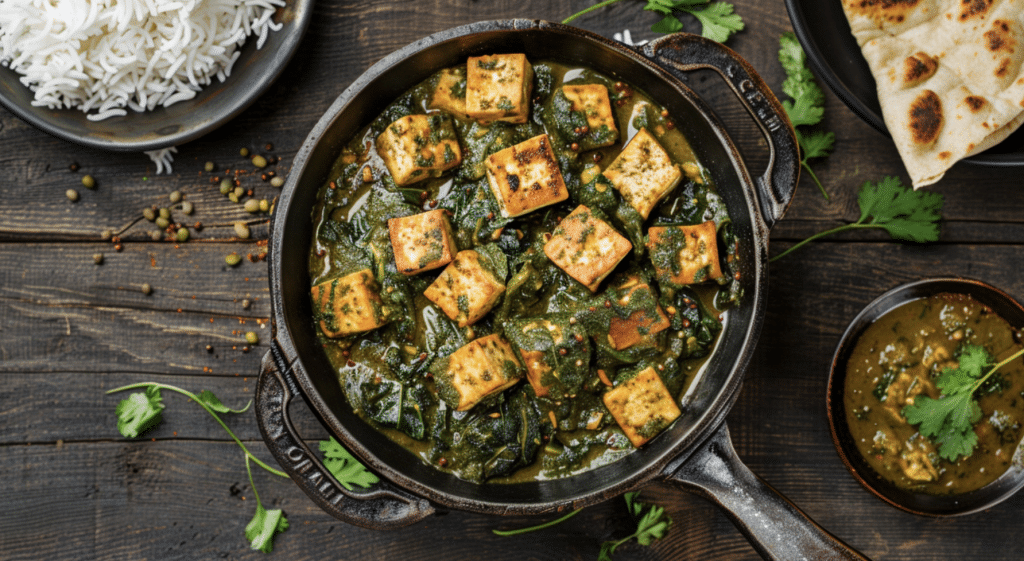
Saag paneer is a classic Indian dish featuring tender cubes of paneer (a type of Indian cottage cheese) simmered in a creamy spinach curry. The spinach is blended with a mix of aromatic spices such as cumin, coriander, turmeric, and garam masala, then cooked with onions, garlic, and ginger to create a flavorful and nutritious base. The paneer adds a delightful texture and a mild, milky flavor to the dish.
- Region of Origin: Saag paneer originated in the northern regions of India, particularly in the states of Punjab and Haryana, where spinach and other leafy greens are abundant.
- Famous for: Saag paneer is renowned for its vibrant green color, creamy texture, and the perfect balance of spices that make it a comforting and satisfying vegetarian meal. It is often served with rice or Indian flatbreads such as naan or roti, making it a staple in Indian restaurants worldwide.
7. Shepherd’s Pie (United Kingdom)

Shepherd’s pie is a traditional British dish consisting of a savory lamb mince (ground lamb) filling topped with a layer of mashed potatoes. The filling is made by sautéing lamb with onions, carrots, and peas, then simmering it in a gravy flavored with Worcestershire sauce, tomato paste, and herbs such as rosemary and thyme. The mashed potato topping is often enriched with butter and milk, creating a creamy and golden-brown crust when baked.
- Region of Origin: Shepherd’s pie originated in the United Kingdom, with roots dating back to the 18th century. It was created as a way to use leftover roasted meat, and the name “shepherd’s pie” refers to the use of lamb, as shepherds tended to sheep.
- Famous for: Shepherd’s pie is celebrated for its hearty, comforting nature and the perfect combination of savory lamb filling and buttery mashed potato topping. It is a quintessential British comfort food that has gained popularity around the world, particularly in pubs and casual dining establishments.
8. Sauerkraut (Germany)
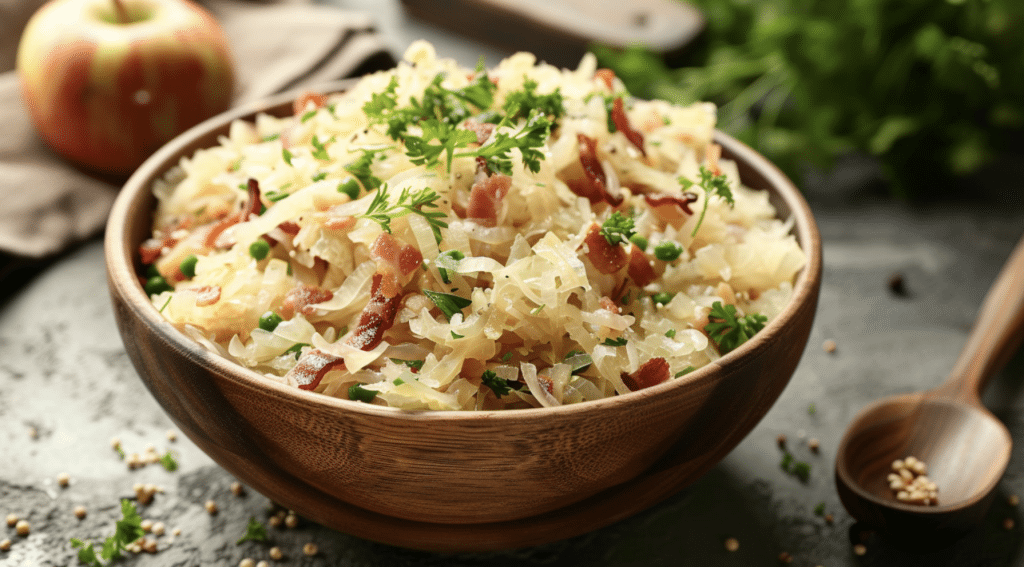
Sauerkraut is a traditional German dish made from finely shredded cabbage that has been fermented with salt. The cabbage is packed tightly into jars or crocks, allowing the natural lactic acid bacteria to ferment the cabbage over several weeks. This process creates a tangy, sour flavor and preserves the cabbage for an extended period. Sauerkraut is often seasoned with juniper berries, caraway seeds, or apples, adding depth and complexity to its flavor profile.
- Region of Origin: Sauerkraut has been a staple in German cuisine for centuries, with records of its consumption dating back to the 16th century. It is believed to have originated in China and was introduced to Europe by Mongolian nomads.
- Famous for: Sauerkraut is renowned for its distinctive sour taste and its versatility as a side dish or condiment. It is often served alongside hearty German meals such as sausages, pork knuckles, and schnitzel, providing a tangy and refreshing contrast to the rich meats. Sauerkraut is also celebrated for its potential health benefits, as the fermentation process creates beneficial probiotics that support digestive health.
9. Som Tam (Thailand)
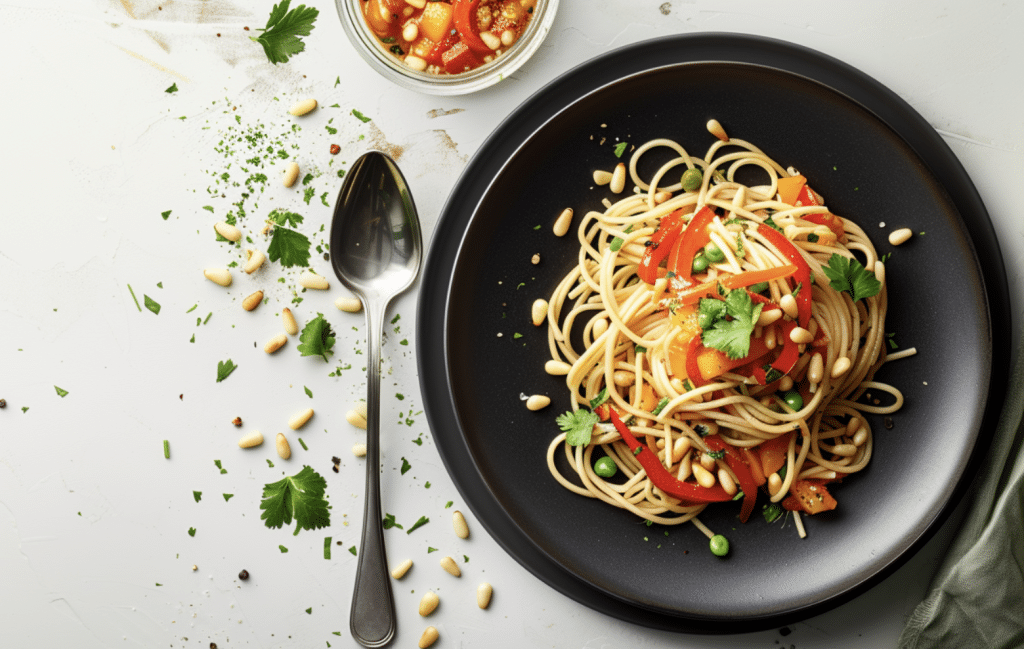
Som tam is a spicy and refreshing Thai salad made from unripe green papaya, cherry tomatoes, green beans, and peanuts, all pounded together with a mortar and pestle. The dressing is a vibrant mix of lime juice, fish sauce, palm sugar, garlic, and fiery bird’s eye chili, creating a perfect balance of sweet, sour, salty, and spicy flavors. The salad is often served with sticky rice and grilled meats, making it a popular street food and a staple in Thai cuisine.
- Region of Origin: Som tam originated in the northeastern region of Thailand, known as Isan, where it is deeply rooted in the local culinary tradition. It has since gained popularity throughout Thailand and has become a beloved dish among locals and tourists alike.
- Famous for: Som tam is celebrated for its bold flavors, contrasting textures, and the invigorating sensation of the chili heat. The combination of crisp, unripe papaya, juicy tomatoes, crunchy peanuts, and the zesty dressing creates a dish that is both refreshing and addictive. Som tam has also gained international recognition, with variations of the dish appearing on Thai restaurant menus around the world.
10. Souvlaki (Greece)

Souvlaki is a popular Greek dish consisting of small pieces of marinated and grilled meat, typically pork or chicken, served on skewers. The meat is marinated in a mixture of olive oil, lemon juice, garlic, and herbs such as oregano and thyme, then grilled over hot coals until tender and slightly charred. Souvlaki is often served with pita bread, tzatziki (a yogurt and cucumber sauce), and a side of fresh vegetables such as tomatoes and onions.
- Region of Origin: Souvlaki has ancient roots in Greece, with references to meat grilled on skewers dating back to ancient Greek literature. It has evolved over time to become a beloved street food and a staple in Greek tavernas.
- Famous for: Souvlaki is renowned for its simple yet flavorful combination of tender, marinated meat and fresh accompaniments. The smoky, grilled aroma and the juicy, succulent texture of the meat make it an irresistible treat. Souvlaki has become an iconic Greek dish, enjoyed by locals and tourists alike as a quick and satisfying meal or a tasty appetizer to share.
11. Soba Noodles (Japan)

Soba noodles are a type of traditional Japanese noodle made from buckwheat flour. They have a distinctive nutty flavor and a slightly chewy texture, making them a popular choice for both hot and cold dishes. Soba noodles can be served in a warm broth with various toppings such as sliced pork, vegetables, and soft-boiled eggs, or chilled with a dipping sauce made from dashi (a Japanese soup stock), soy sauce, and mirin (sweet rice wine).
- Region of Origin: Soba noodles have been a part of Japanese cuisine for centuries, with their origin dating back to the Edo period (1603-1868). They are particularly associated with the mountainous regions of Japan, where buckwheat is a common crop.
- Famous for: Soba noodles are celebrated for their unique flavor and texture, as well as their versatility in both hot and cold dishes. They are often enjoyed on special occasions, such as New Year’s Eve, when eating soba noodles is believed to bring good luck and longevity. Soba noodles are also valued for their nutritional benefits, as buckwheat is rich in protein, fiber, and essential nutrients.
12. Sacher Torte (Austria)

Sacher torte is a classic Austrian chocolate cake consisting of two layers of dense, chocolate sponge cake filled with apricot jam and coated in a rich, dark chocolate glaze. The cake is made with high-quality chocolate, butter, sugar, and eggs, resulting in a decadent and indulgent dessert. Sacher torte is often served with unsweetened whipped cream on the side, which helps to balance the richness of the chocolate.
- Region of Origin: Sacher torte was created in 1832 by Franz Sacher, a 16-year-old apprentice chef in Vienna, Austria. He was asked to create a special dessert for Prince Metternich, and the resulting cake became an instant classic.
- Famous for: Sacher torte is renowned for its perfect balance of flavors and textures, with the slightly tart apricot jam complementing the rich chocolate cake and glaze. It has become an iconic Austrian dessert, enjoyed by locals and tourists alike in the famous Sacher Hotel in Vienna, as well as in cafes and pastry shops around the world. The cake’s enduring popularity is a testament to its timeless appeal and the skilled craftsmanship of Austrian pastry chefs.
13. Saltimbocca (Italy)
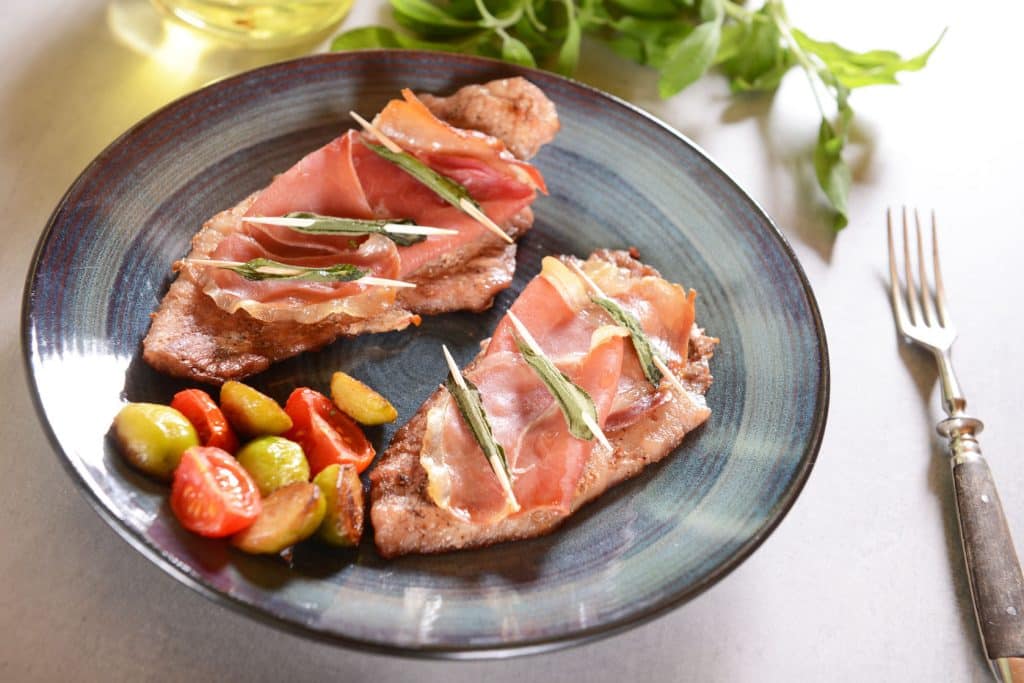
Saltimbocca is a classic Italian dish consisting of thin slices of veal or chicken topped with prosciutto and sage leaves, then pan-fried in butter and white wine. The name “saltimbocca” translates to “jump in the mouth,” referring to the burst of flavors that occurs when biting into the dish. The tender meat, salty prosciutto, and fragrant sage create a harmonious combination that is both simple and sophisticated.
- Region of Origin: Saltimbocca is believed to have originated in the Lazio region of Italy, particularly in the city of Rome. It has since become a beloved dish throughout Italy and has gained popularity in Italian restaurants worldwide.
- Famous for: Saltimbocca is celebrated for its delightful interplay of flavors and textures, with the thin, tender meat, crispy prosciutto, and aromatic sage coming together in each bite. The dish is often served with a pan sauce made from the cooking juices, butter, and white wine, which adds depth and richness to the overall flavor profile. Saltimbocca’s simplicity and elegance make it a favorite among Italian food enthusiasts and a staple in Italian fine dining.
14. Saag Aloo (India)

Saag aloo is a popular Indian dish consisting of potatoes (aloo) cooked in a spinach (saag) curry. The potatoes are typically parboiled and then sautéed with onions, garlic, ginger, and a blend of aromatic spices such as cumin, coriander, turmeric, and garam masala. The spinach is blanched, pureed, and then simmered with the spiced potatoes until the flavors meld together, creating a thick and creamy curry.
- Region of Origin: Saag aloo is a staple in North Indian cuisine, particularly in the states of Punjab and Uttar Pradesh. It is a popular vegetarian dish that is enjoyed throughout the country and has gained recognition in Indian restaurants worldwide.
- Famous for: Saag aloo is renowned for its vibrant green color, velvety texture, and the comforting combination of tender potatoes and flavorful spinach curry. The dish is often served as a side dish or as a main course accompanied by rice or Indian flatbreads such as naan or roti. Saag aloo’s popularity stems from its appealing mix of healthy ingredients, aromatic spices, and satisfying flavors that make it a go-to choice for vegetarians and meat-eaters alike.
15. Sticky Toffee Pudding (United Kingdom)

Sticky toffee pudding is a beloved British dessert consisting of a moist, date-infused sponge cake drenched in a rich toffee sauce. The cake is made with chopped dates, which are simmered in water or coffee until soft and then mixed into a batter of flour, butter, sugar, and eggs. Once baked, the warm cake is poked with holes and drizzled with a decadent toffee sauce made from butter, brown sugar, and heavy cream.
- Region of Origin: The exact origin of sticky toffee pudding is somewhat disputed, but it is believed to have originated in the Lake District of North West England in the 1970s. The dessert quickly gained popularity throughout the United Kingdom and has since become a cherished treat in British pubs, restaurants, and homes.
- Famous for: Sticky toffee pudding is celebrated for its irresistible combination of moist, tender cake and the indulgent, gooey toffee sauce that soaks into every bite. The natural sweetness of the dates perfectly complements the rich, caramel-like flavor of the sauce, creating a dessert that is both comforting and luxurious. Sticky toffee pudding is often served warm with a scoop of vanilla ice cream or a dollop of unsweetened whipped cream, making it a truly decadent treat.
16. Shakshuka (Middle East/North Africa)

Shakshuka is a flavorful and vibrant dish consisting of eggs poached in a spiced tomato and pepper sauce. The sauce is made by sautéing onions, garlic, and bell peppers, then simmering them with tomatoes, spices such as cumin, paprika, and cayenne pepper, and sometimes additional ingredients like feta cheese or chorizo. The eggs are then cracked directly into the sauce and cooked until the whites are set but the yolks remain runny.
- Region of Origin: Shakshuka has roots in Middle Eastern and North African cuisine, with variations of the dish popular in countries such as Israel, Tunisia, Morocco, and Algeria. Its exact origin is uncertain, but it has become a beloved breakfast and brunch staple in these regions and beyond.
- Famous for: Shakshuka is renowned for its bold, savory flavors and the delightful contrast of the velvety poached eggs against the robust tomato and pepper sauce. The dish is often served with crusty bread or pita for dipping, allowing diners to soak up every last bit of the flavorful sauce. Shakshuka’s popularity has spread worldwide, with cafes and restaurants featuring it on their menus as a tasty and satisfying meal any time of day.
17. Smorrebrod (Denmark)

Smorrebrod is a traditional Danish open-faced sandwich consisting of a slice of rye bread topped with various ingredients such as butter, cheese, cold cuts, fish, and vegetables. The toppings are artfully arranged to create a visually appealing and flavorful combination, often incorporating contrasting textures and colors. Some popular variations include pickled herring with dill and onions, roast beef with remoulade and crispy onions, and Danish blue cheese with apple and walnut.
- Region of Origin: Smorrebrod has been a part of Danish cuisine since the 19th century, evolving from simple farmers’ lunches to a more elaborate and artistic presentation in the early 20th century. It remains a beloved and iconic Danish dish, enjoyed in homes, cafes, and restaurants throughout the country.
- Famous for: Smorrebrod is celebrated for its infinite variety and the creativity that goes into crafting each sandwich. The use of high-quality, fresh ingredients and the attention to detail in the presentation make smorrebrod a true culinary art form. Smorrebrod has also gained international recognition, with Danish-inspired restaurants and cafes around the world offering their own interpretations of this classic dish.
18. Sosaties (South Africa)
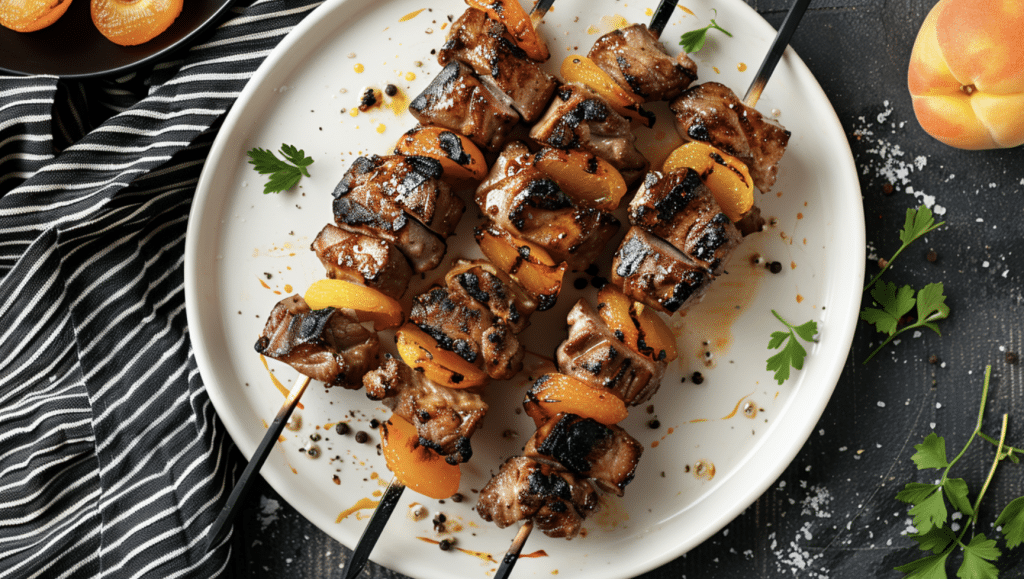
Sosaties are a popular South African skewered meat dish that perfectly blends savory and sweet flavors. Marinated lamb or mutton cubes are skewered with onions, dried apricots, and sometimes bell peppers, then grilled to perfection. The meat is infused with a flavorful mixture of curry powder, turmeric, garlic, ginger, and vinegar, creating a unique taste sensation.
- Region of Origin: Sosaties originated from the Cape Malay community in the Western Cape region of South Africa, where their culinary traditions were influenced by Dutch and other European cuisines.
- Famous for: Sosaties are renowned for their unique fusion of flavors, textures, and cultural influences. They are a beloved part of South African heritage, often enjoyed at braais (barbecues), and represent the country’s diverse culinary landscape.
19. Schnitzel (Austria/Germany)

Schnitzel is a popular Austrian and German dish consisting of thin, boneless meat (usually veal or pork) that is breaded and fried until golden and crispy. The meat is pounded thin, then coated in flour, beaten eggs, and breadcrumbs before being fried in butter or oil. The result is a tender, juicy interior encased in a satisfyingly crunchy exterior. Schnitzel is often served with a wedge of lemon, potato salad, or French fries.
- Region of Origin: Schnitzel is believed to have originated in Austria, with the famous Wiener Schnitzel (Viennese Schnitzel) made from veal and traditionally served with a potato salad. Variations of the dish, such as pork schnitzel, have become popular in Germany and other Central European countries.
- Famous for: Schnitzel is renowned for its crispy, golden-brown exterior and the tender, flavorful meat inside. The dish has become an iconic representation of Austrian and German cuisine, enjoyed in restaurants, pubs, and homes throughout the region. Its popularity has also spread internationally, with schnitzel appearing on menus in restaurants around the world.
20. Soto Ayam (Indonesia)
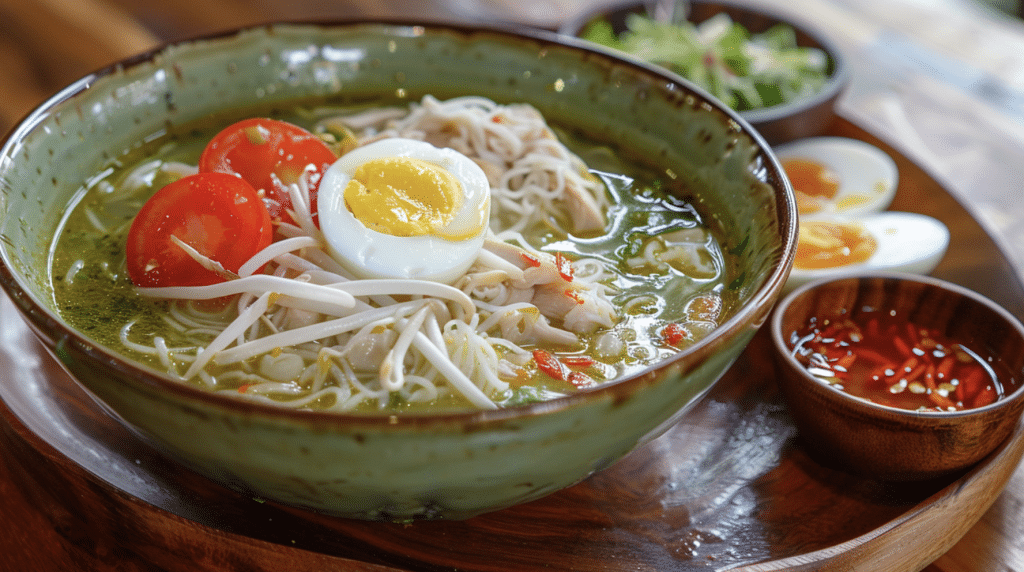
Soto ayam is a traditional Indonesian chicken soup featuring a fragrant, spiced broth, shredded chicken, and various garnishes. The broth is made by simmering chicken with aromatic ingredients such as lemongrass, kaffir lime leaves, galangal, and turmeric, creating a flavorful and comforting base. The soup is then served with shredded chicken, rice noodles or compressed rice cakes, boiled eggs, and an array of garnishes like fried shallots, lime wedges, and chili sauce.
- Region of Origin: Soto ayam is a beloved dish throughout Indonesia, with regional variations found across the country. It is particularly associated with the island of Java, where it is a popular street food and a staple in local households.
- Famous for: Soto ayam is celebrated for its complex and aromatic broth, which showcases the rich flavors of Indonesian spices and herbs. The combination of tender chicken, noodles or rice cakes, and the fresh, crunchy garnishes creates a satisfying and nourishing meal that appeals to all the senses. Soto ayam is often enjoyed for breakfast or lunch and is a go-to comfort food for many Indonesians.
21. Sopaipillas (Chile)

Sopaipillas are traditional Chilean fried pastries made from a dough of pumpkin, flour, butter, and sugar. The dough is rolled out, cut into circular or diamond shapes, and then deep-fried until golden brown and crispy. The resulting pastries are slightly sweet, with a subtle pumpkin flavor and a satisfyingly chewy texture. Sopaipillas are often served drizzled with a sweet syrup made from chancaca (unrefined sugar) or honey.
- Region of Origin: Sopaipillas are a beloved treat in Chile, particularly during the winter months and festivals such as Independence Day and Christmas. They are also popular in other parts of South America, with variations found in countries like Argentina and Peru.
- Famous for: Sopaipillas are renowned for their crispy exterior, soft and chewy interior, and the delightful combination of sweet and savory flavors. They are often enjoyed as a snack or dessert, accompanied by a cup of coffee or tea. Sopaipillas have become an iconic part of Chilean cuisine and cultural heritage, with generations of families passing down their recipes and traditions.
22. Salzburger Nockerl (Austria)

Salzburger Nockerl is a sweet soufflé-like dessert from the Austrian city of Salzburg. This heavenly dish consists of three mounds of fluffy, cloud-like meringue delicately flavored with vanilla and dusted with powdered sugar. The meringue is gently baked until golden brown on the outside while remaining soft and creamy on the inside. Underneath the pillowy mounds lies a luscious pool of tart berry compote, often made with raspberries or lingonberries, providing a delightful contrast to the sweetness of the meringue.
- Region of Origin: Salzburger Nockerl originated in the picturesque city of Salzburg, Austria, known for its baroque architecture and musical heritage. Legend has it that the dessert was created by Salome Alt, the mistress of Prince-Archbishop Wolf Dietrich von Raitenau, in the early 17th century.
- Famous for: Salzburger Nockerl is renowned for its stunning presentation, with the three towering meringue peaks said to represent the three hills surrounding the city of Salzburg. The dessert’s light, airy texture and the perfect harmony of sweet meringue and tangy fruit compote make it a beloved treat among locals and tourists alike.
23. Strudel (Austria/Germany)

Strudel is a traditional Austrian and German pastry consisting of a thin, flaky dough filled with various sweet or savory ingredients. The most famous variety is the apple strudel (Apfelstrudel), which features a filling of sliced apples, cinnamon, sugar, and sometimes raisins or nuts. Other popular fillings include cherry, cheese, potato, and sauerkraut. The filled dough is rolled up, brushed with butter or oil, and then baked until golden brown and crispy.
- Region of Origin: Strudel originated in Austria during the Habsburg Empire, with influences from Turkish and Hungarian cuisine. It later spread to Germany and other parts of Central and Eastern Europe, becoming a beloved pastry in the region.
- Famous for: Strudel is celebrated for its delicate, flaky pastry and the warm, comforting fillings that make it a perfect treat for any occasion. The combination of sweet, spiced apples and buttery pastry in the classic apple strudel has made it an iconic dessert in Austrian and German cuisine. Strudel is often served warm, dusted with powdered sugar, and accompanied by vanilla sauce, whipped cream, or a scoop of ice cream.
24. Smokva (Croatia)

Smokva is a delightful Croatian dessert that showcases the country’s love for figs. This simple yet elegant dish features fresh, ripe figs gently poached in a syrup infused with the warm, aromatic notes of cinnamon, vanilla, and sometimes a touch of brandy or wine. The poached figs are then served warm, often accompanied by a scoop of creamy vanilla ice cream or a dollop of whipped cream.
- Region of Origin: Smokva is enjoyed throughout Croatia, particularly in the coastal regions of Dalmatia and Istria, where fig trees thrive in the Mediterranean climate. Figs have been an essential part of Croatian cuisine for centuries, with the fruit celebrated for its versatility and natural sweetness.
- Famous for: Smokva is praised for its ability to highlight the natural beauty and flavor of fresh figs, elevating them with a simple yet sophisticated preparation. The dish’s warm, comforting nature and the perfect balance of sweetness and spice make it a cherished treat in Croatian homes and restaurants, particularly during the late summer and early autumn when figs are at their peak.
25. Szechuan Chicken (China)
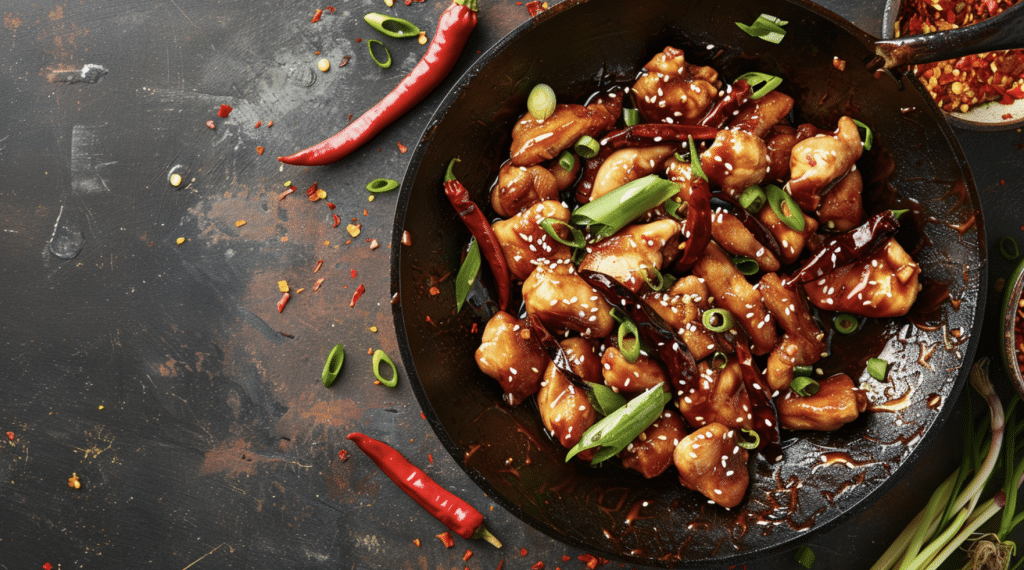
Szechuan Chicken is a spicy and flavorful Chinese dish originating from the Sichuan province. It features tender, marinated chicken pieces stir-fried with a variety of vegetables and tossed in a bold, spicy sauce. The sauce is made with Sichuan peppercorns, dried chili peppers, garlic, ginger, and other seasonings, creating a complex balance of heat, umami, and a slight numbing sensation known as “ma la.”
- Region of Origin: Szechuan Chicken is a staple of Sichuan cuisine, which is renowned for its bold, spicy flavors and use of Sichuan peppercorns. The dish has gained popularity throughout China and has become a favorite in Chinese restaurants worldwide.
- Famous for: Szechuan Chicken is celebrated for its fiery, mouth-tingling flavor profile and the harmonious blend of tender chicken, crisp vegetables, and addictive, spicy sauce. The unique numbing sensation from the Sichuan peppercorns, combined with the heat from the chili peppers, creates a thrilling and unforgettable dining experience.
Conclusion
From the delicate flavors of Japanese sushi to the fiery kick of Szechuan chicken, these 25 items that start with S have taken us on an unforgettable culinary journey.
We’ve explored an array of dishes that showcase the incredible diversity and ingenuity of global cuisine, each one offering a unique combination of flavors, textures, and cultural significance.
Through our exploration of these items that start with S, we’ve discovered that food is more than just sustenance; it is a celebration of creativity, a bridge between cultures, and a testament to the human spirit’s ability to transform simple ingredients into something extraordinary.
As we conclude our alphabetical adventure, we can’t help but marvel at the vast tapestry of flavors and traditions that make up the world’s culinary landscape.
So, let us raise our forks in tribute to these 25 delectable dishes, and to the countless other items that start with S and beyond, waiting to be discovered and savored.







